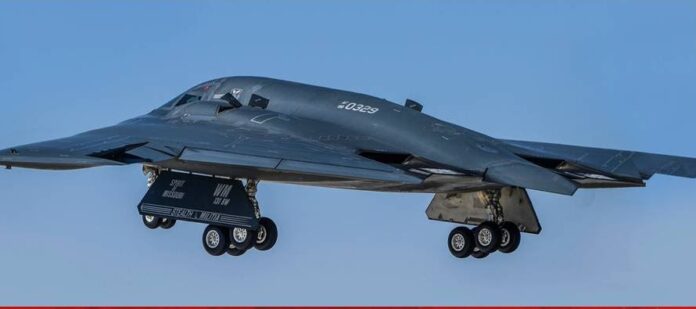U.S. stealth bombers strike Iran’s top nuclear sites after a massive 18‑hour covert mission from Missouri.
In the dead of night, seven US B‑2 stealth bombers lifted off from Whiteman Air Force Base, Missouri. Their target: Iran’s most fortified nuclear facilities. Dubbed Operation Midnight Hammer, the mission stunned the world when the Pentagon revealed its shocking scale—stealth aircraft, cruise missiles, aerial decoys and real-time deception all converging in a coordinated 25-minute blitz.
The operation began at 00:01 EDT on 21 June 2025. As the bombers quietly slipped eastward over the Atlantic, another fleet of B‑2s launched westward toward Guam. That second group, according to US defence officials, was a decoy—an elaborate distraction known to only a handful of top military planners.
Meanwhile, the real strike force travelled in radio silence for over 18 hours, mid-air refuelled multiple times, and approached Iranian airspace around 17:00 EDT. Just before crossing into Iran, they were joined by fighter escorts sweeping ahead to neutralise any air defence threats.
But Iran didn’t strike back. No fighter jets launched. No surface-to-air missiles fired. The US claims Israel’s earlier air dominance over Iranian skies helped pave the way. It gave American bombers full freedom to strike, unopposed.
Then came the assault.
At 18:40 EDT, the lead B‑2 bomber dropped two GBU‑57 Massive Ordnance Penetrators—30,000 lb “bunker busters”—on the Fordo nuclear site, buried beneath a mountain, up to 90 metres deep. It marked the first time these bunker-busting bombs had ever been used in live combat.
In total, 14 bunker busters hit Fordo and Natanz. Simultaneously, over two dozen Tomahawk cruise missiles, fired from a US submarine in the Arabian Sea, slammed into Iran’s nuclear site near Isfahan.
All targets were struck within a half-hour window. The bombers then turned back, spending another 18 hours in flight to return to the US, completing one of the most sophisticated air missions in American military history.
More than 125 US aircraft participated, with 75 precision-guided munitions deployed. The Pentagon called it a coordinated masterpiece. Defence Secretary Pete Hegseth hailed it as a “clear and powerful demonstration” of American force, while Joint Chiefs Chairman Gen. Dan Caine praised the successful deception tactics and the operation’s precision.
Yet the full impact remains unclear. Satellite imagery shows significant surface damage, but whether Iran’s deeply buried enrichment tunnels were fully destroyed will take time to assess.
Iranian officials acknowledged the attack but downplayed the damage, claiming only minimal impact. They denied any nuclear material had been leaked or compromised, and described the strikes as a “reckless provocation.”
Iran’s government has vowed retaliation but has yet to outline its next move.
Inside the US, the operation has ignited fierce debate. President Donald Trump, Vice-President JD Vance, and Secretary of State Marco Rubio had gathered in the White House Situation Room to monitor the strike in real-time. Critics, however, have questioned the lack of congressional authorisation for what some are calling an act of war.
Still, military analysts have called the strike unprecedented.
“This was an incredibly complex and surgically executed operation,” said Dr Stacie Pettyjohn of the Centre for a New American Security. “No other country could have pulled this off.”
While Trump has declared Iran’s nuclear programme “obliterated,” others urge caution. The real test, experts say, is whether the operation achieves lasting strategic gains, or simply delays the inevitable
